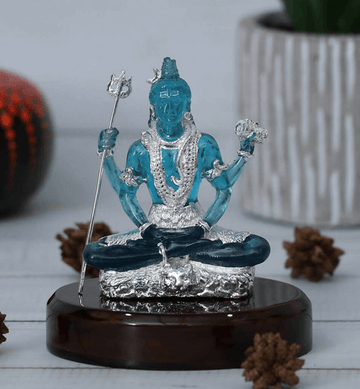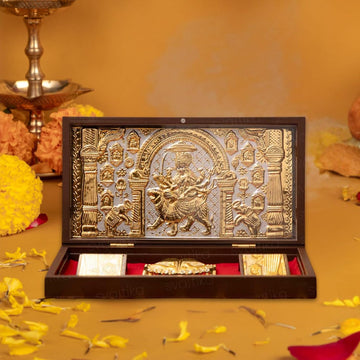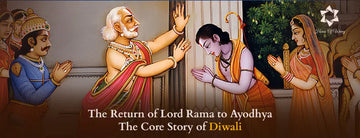Every year, the entire India witnesses the hearty welcome of lord Ganesha idols with devotion and joy. The Ganesh Chaturthi festival is all about inviting Vighnaharta into one's life and letting him take away all the obstacles and seek blessings for wisdom. Ganesha Visarjan is celebrated with the same grandeur and devotion as the welcoming of Lord Ganesha.
It is not just a ritual of Ganesha idol immersion into rivers, but a deep mythological meaning. It is considered to be Ganesha’s journey to Kailash, back to his father Shiva, and mother Parvati. This journey reminds us of detachment, the cycle of creation, and dissolution.
Just as Indian grandmothers remind us during the Visarjan, “Vighnaharta jayenge vighna sath le jayenge”
The Mythological Story of Ganesha Visarjan
The story of Ganesha’s journey to Kailash Parvat represents love, duty, and balance in life. As per the Puranas, it is written that every creation will always have dissolution. Just like Ganesh Chaturthi, where Lord Ganpati blesses his devotees and returns to Mount Kailash. The return of Ganesha teaches that when divine energies come to visit us, they must eventually return to their origins.
- Lord Ganesha visits our homes as an honored guest, bringing joy and blessings.
- His return reminds us of the natural cycle of life: beginnings, celebrations, and endings.
- The Visarjan means union with the divine and the infinite universe.
As we know, our nanis and dadis always shared that Ganesha, while playful and loving, was dutiful to his parents. His immersion is not a loss; it is a reunion.
Symbolic Meaning of Ganapati’s Journey to Kailash
The meaning of Ganesh Visarjan is not limited to mythology alone. It holds greater spiritual truths:
- Detachment: Like we allow Ganapati to depart after ten days, detachment is a lesson in life.
- Cycle of Nature: The Lord Ganesha Idols dissolve in water as a reminder of "mitti se aye hai mitti mein mil jayenge."
- Energy Flow: Ganesha absorbs negative energies during his stay and carries them away during Visarjan.
- Hope and Renewal: His departure is not an ending, but a promise of returning next year.
Also, as kids, didn’t we all sing? “Tujhko Phir Se Jalwa Dikhana Hi Hoga
Agle Baras Aana Hai, Aana Hi Hoga” As if asking a Friend to visit again
Why Ganesha Visarjan Marks the End of Ganesh Chaturthi
There is Ganesh Chaturthi significance at both its beginning and its end. The festival begins with sthapana (idol installation) and ends with visarjan (idol immersion). Not completing visarjan means the cycle is incomplete.
- It teaches us to accept that nothing is permanent.
- It allows the energy of the idol to return to nature.
- It acts as a way of showing gratitude for the blessings we have received.
As every Indian father says, "You don't send Ganapati off with a tear, but a prayer." Remember not to sob yourself but to seek blessings while waiting for Bappa to return.
Rituals and Customs Followed During Visarjan
The Ganapati Visarjan customs may differ slightly across India, but always carry the same spirit of devotion:
- Aarti and Bhajans are sung on Ganapati Agman,
- Flowers, coconut, and Modak are offered to Ganapati,
- Prayers are made by families for prosperity and protection,
- A parade exits from a house with dance and music before the immersion takes place.
Surely everyone remembers all the streets full of slogans like “Ganapati Bappa Morya, Pudhchya Varshi Lavkar Ya” during a visarjan.
Different Types of Ganesha Visarjan (One-day, 5-day, 10-day)
Not every family keeps Ganapati for 10 days, as traditions differ across households:
- One-day visarjan: For the families that want a simple puja.
- 5-day visarjan: Quite auspicious in many families.
- 10-day visarjan: Most common, which ends on Anant Chaturdashi.
Often our elders say, “Chhoti ya badi pooja nahi hoti, shraddha sabse badi hoti hai” - You may even have observed yourself how even a small idol that is loved and worshiped, brings as much joy as a large one.
Cultural Importance of Ganapati Visarjan Across India
Ganesh Chaturthi is celebrated throughout India in many different forms and styles.
- Maharashtra is well-known for its large public celebrations and parades.
- Goa & Karnataka have a mixture of household traditions and community-based celebrations.
- Tamil Nadu & Andhra Pradesh have highly ritualized temple celebrations.
- Northern India is gaining popularity and has smaller celebrations.
Festivals are not just rituals; they unite communities, bringing together even those who have not met for months.
Eco-Friendly Ganesha Visarjan Practices
In the past few years, various water pollution concerns have led to eco-friendly Ganesha Visarjan practices. Instead of plaster idols, families today prefer eco-friendly clay idols with natural clay idols that are easier to dissolve.
Some eco-friendly practices related to visarjan are:
- Using natural dyes or colors with biodegradable decorations.
- Setting up artificial water tanks to be immersed.
- Requesting small idols to limit any waste.
My dadi used to say, "Prakriti bhi maa hai, usey bhi dukh mat do.”
Popular Cities Known for Grand Ganesha Visarjan Processions
Certain cities have become popular with their visarjan parades:
- Mumbai is known for Lalbaugcha Raja with huge crowds.
- Pune is known for old-school dhol-tasha parades.
- Hyderabad holds one of the tallest Ganesha statues.
- Goa temple culture and beach immersion are most beautiful.
Devotional Songs, Dances, and Chants During Visarjan
The atmosphere during visarjan is energetic:
- The beat of the dhol and tasha echoes through the streets.
- Lezim and folk dances add foot taps to worship.
- The chants of Ganpati Bappa Morya elevate spirits.
As we know, music connects us all. Have you felt the goosebumps when the crowd chants in unison and the vibrations fill the atmosphere?
Spiritual Lessons from Ganesha’s Departure to Kailash
The spiritual significance of Ganesh Visarjan conveys lessons for life:
- Celebrate the moment, but at the end, know how to say goodbye.
- Detachment is as precious as attachment.
- Faith persists in the absence.
As our elders often say, “Bhagwan hamesha dil mein hote hain, murti toh sirf ek madhyam hai,” and just like that, you may have experienced that even after visarjan, Ganpati stays with you through memories and blessings.
Conclusion
The journey of lord Ganesha idols from sthapana to visarjan is more than ritual; it is a story of devotion, of nature, and of spirituality. The Ganesh Chaturthi festival culminates with visarjan, but blessings continue forever. Ganesha's return to Kailash reminds us of the cycles of arrival and departure, of attachment and detachment, of welcoming and farewell. Such a balance makes life beautiful.
So, as we bid farewell to Bappa every year, let's do that in gratitude and joy and with eco-friendly devotion, knowing he will return.
Let’s say Ganpati Bappa Morya! Pudhchya Varshi Lavkar Ya!
And, as we come to an end to this story, stay tuned, our next blog will bring another spiritual story of What is Pitrupaksha?










